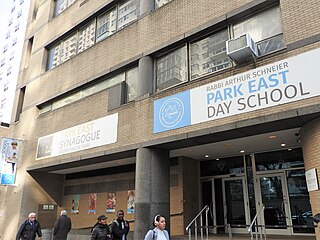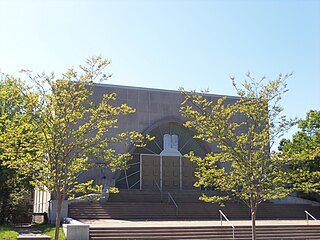
Shlomo Riskin is an Orthodox rabbi, and the founding rabbi of Lincoln Square Synagogue on the Upper West Side of New York City, which he led for 20 years; founding chief rabbi of the Israeli settlement of Efrat in the Israeli-occupied West Bank; dean of Manhattan Day School in New York City; and founder and Chancellor of the Ohr Torah Stone Institutions, a network of high schools, colleges, and graduate Programs in the United States and Israel. He belongs to the Open Orthodox stream of Judaism.
Hebrew school can be either an educational regimen separate from secular education similar to the Christian Sunday school, education focusing on topics of Jewish history and learning the Hebrew language, or a primary, secondary or college level educational institution where some or all of the classes are taught in Hebrew.

Talmud Torah schools were created in the Jewish world, both Ashkenazic and Sephardic, as a form of religious school for boys of modest backgrounds, where they were given an elementary education in Hebrew, the scriptures, and the Talmud. This was meant to prepare them for yeshiva or, particularly in the movement's modern form, for Jewish education at a high school level. The Talmud Torah was modeled after the cheder, a traditional form of schooling whose essential elements it incorporated, with changes appropriate to its public form rather than the cheder's private financing through less formal or institutionalized mechanisms, including tuition fees and donations.
Judah David Bleich is an authority on Jewish law and ethics, including Jewish medical ethics. He is a professor of Talmud at the Rabbi Isaac Elchanan Theological Seminary, an affiliate of Yeshiva University, as well as head of its postgraduate institute for the study of Talmudic jurisprudence and family law. At Yeshiva University, he holds the Herbert and Florence Tenzer Chair in Jewish Law and Ethics. He also teaches at Cardozo Law School. He is married to Dr. Judith Bleich, a historian of 19th-century European Jewry.

Torah Umesorah – National Society for Hebrew Day Schools is an Orthodox Jewish educational charity based in the United States that promotes Torah-based Jewish religious education in North America by supporting and developing a loosely affiliated network independent private Jewish day schools.

The First Roumanian-American Congregation, also known as Congregation Shaarey Shomayim, or the Roumanishe Shul, was an Orthodox Jewish congregation that, for over 100 years, occupied a historic building at 89–93 Rivington Street on the Lower East Side of Manhattan, New York.

Jewish education is the transmission of the tenets, principles, and religious laws of Judaism. Known as the "people of the book", Jews value education, and the value of education is strongly embedded in Jewish culture. Judaism places a heavy emphasis on Torah study, from the early days of studying the Tanakh.

Congregation Baith Israel Anshei Emes, more commonly known as the Kane Street Synagogue, is an egalitarian Conservative synagogue located at 236 Kane Street in Cobble Hill, Brooklyn, New York City, United States. It is currently the oldest continuously operating synagogue in Brooklyn.

Park East Day School is a Jewish day school located on the Upper East Side of the Borough of Manhattan in New York City. It includes an early childhood program, an elementary school, and a middle school that graduates students after eighth grade. In 1950's Rabbi Zev Zahavy and his wife Edith, a noted educator, founded the school with funding from Henry H. Minskoff. In 1976 Rabbi Arthur Schneier started Park-East's early childhood facility. In 1981, the nursery school merged with the East Side Hebrew Institute ("ESHI"), once one of the major Jewish institutions of the Lower East Side, which had classes ranging from Nursery, Kindergarten and up to the 12th grade. The new merged school was named "Park East ESHI". Several years later, the new school board omitted the word "ESHI" and in 1990 they renamed the school after Rabbi Schneier.
Joseph Kaminetsky was an American Orthodox rabbi who became the pioneering first director of Torah Umesorah – National Society for Hebrew Day Schools of North America, based in New York City. He was directly responsible for the establishment of hundreds of yeshiva day schools across the United States outside of the New York Metropolitan Area.

Old Broadway Synagogue is an Orthodox Jewish synagogue in the Manhattanville neighborhood of Manhattan in New York City incorporated in 1911 under the name Chevra Talmud Torah Anshei Marovi, by an immigrant named Morris Schiff. Schiff was a Polish immigrant who lived in the Harlem area, an area with a high Jewish population at the time. The building is listed individually on the National Register of Historic Places.
B'nai Emet Synagogue was a Conservative synagogue located in St. Louis Park, Minnesota affiliated with the United Synagogue of Conservative Judaism. St. Louis Park is a city in Hennepin County, Minnesota and a first ring-suburb immediately west of Minneapolis.

Breed Street Shul, also known as Congregation Talmud Torah of Los Angeles or Breed Street Synagogue, is an Orthodox Jewish synagogue in the Boyle Heights section of Los Angeles, California. It was the largest Orthodox synagogue west of Chicago from 1915 to 1951, and is listed in the National Register of Historic Places.

Ohev Sholom – The National Synagogue ; OSTNS is the oldest Orthodox synagogue in Washington, D.C.

East Midwood Jewish Center is a Conservative synagogue located at 1625 Ocean Avenue, Midwood, Brooklyn, New York City.

Mesivta is an Orthodox Jewish yeshiva secondary school for boys. The term is commonly used in the United States to describe a yeshiva that emphasizes Talmudic studies for boys in grades 9 through 11 or 12; alternately, it refers to the religious studies track in a yeshiva high school that offers both religious and secular studies.

Ansche Chesed is a synagogue on the Upper West Side of the New York City borough of Manhattan.

Max D. Raiskin, was a rabbi, Professor of Hebrew Literature, licensed Certified Public Accountant, author of educational textbooks, and the principal and executive director of the East Side Hebrew Institute.

Barbara Elefant-Raiskin was a Jewish American-Israeli educator, university lecturer, poet, painter, author of children's literature and textbooks.
















